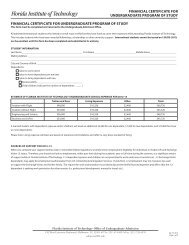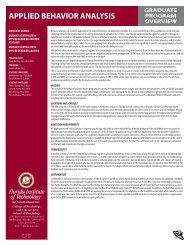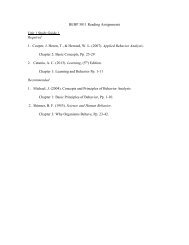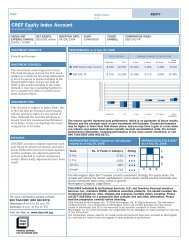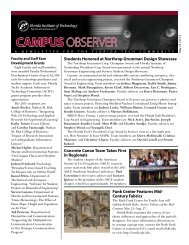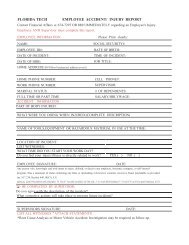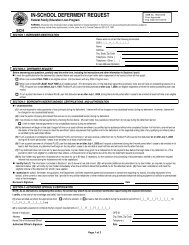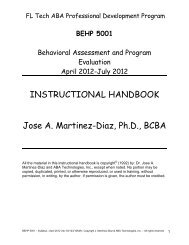2011–2012 UNIVERSITY CATALOG - Florida Institute of Technology
2011–2012 UNIVERSITY CATALOG - Florida Institute of Technology
2011–2012 UNIVERSITY CATALOG - Florida Institute of Technology
Create successful ePaper yourself
Turn your PDF publications into a flip-book with our unique Google optimized e-Paper software.
ECE 5118 WIRELESS SENSOR NETWORKS (3 credits). Pervasive networks<br />
and network embedded systems, power-aware issues in wireless sensor networks,<br />
collaborative signal and information processing, routing and MAC protocols in sensor<br />
networks, clustering and coordination in sensor networks, sensor networks applications.<br />
(Requirement: Graduate standing.)<br />
ECE 5201 LINEAR SYSTEMS 1 (3 credits). Studies linear spaces, linear operators<br />
and matrix calculus; mathematical description <strong>of</strong> linear dynamic systems, the<br />
relation between state variable descriptions and system transfer functions; controllability<br />
and observability <strong>of</strong> systems, realization <strong>of</strong> rational transfer function matrices<br />
and introduces nonlinear analysis. Prerequisites: ECE 4231 or MTH 2201.<br />
ECE 5221 PERSONAL COMMUNICATION SYSTEMS (3 credits). Overviews<br />
the principles <strong>of</strong> operation, general architectures, access methods, modulation<br />
schemes and performance <strong>of</strong> cellular and personal communications systems. Presents<br />
design criteria for modern systems and use <strong>of</strong> real world tools to demonstrate design<br />
concepts. Prerequisites: ECE 4221.<br />
ECE 5223 DIGITAL COMMUNICATIONS (3 credits). Covers physical media,<br />
digital modulation, detection, intersymbol interference, adaptive equalization, spectrum<br />
control, error control and synchronization. Prerequisites: ECE 4221, MTH 5425.<br />
ECE 5233 SATELLITE COMMUNICATIONS (3 credits). A comprehensive<br />
study <strong>of</strong> the systems aspects <strong>of</strong> satellite communications, with emphasis on digital<br />
communications. Includes an analysis <strong>of</strong> AWGN channels, performance degradation<br />
caused by band limiting, nonlinearities, phase noise, etc. Presents a survey <strong>of</strong> existing<br />
operational satellite systems. Prerequisites: ECE 4221.<br />
ECE 5234 COMMUNICATION THEORY (3 credits). Covers theory <strong>of</strong> signal<br />
spaces; dimensionality and distance; optimum methods <strong>of</strong> statistical detection and<br />
estimation; characteristics <strong>of</strong> noise; introduction to information theory, including<br />
channel capacity, source coding and channel coding; and time-bandwidth limitations<br />
and rate-distortion theory. Prerequisites: ECE 4221.<br />
ECE 5238 ERROR CONTROL CODING (3 credits). Introduces algebra, linear<br />
block codes, Galois fields, cyclic codes, circuits for cyclic codes, BCH codes, spectral<br />
techniques for encoding and decoding, and convolutional codes.<br />
ECE 5243 DIGITAL CONTROL SYSTEMS (3 credits). Analyzes and designs<br />
digital control systems using state-variable techniques and time-domain analysis;<br />
sampling, z-transform analysis and the frequency domain; and controllability and<br />
observability. Prerequisites: ECE 5201.<br />
ECE 5245 DIGITAL SIGNAL PROCESSING 1 (3 credits). Describes discretetime<br />
signals in the time and frequency domains; z-transform, discrete Fourier<br />
transform, FFT algorithms; introduction to classical digital filter design techniques;<br />
and filter banks.<br />
ECE 5248 ADVANCED FILTERING (3 credits). Bayesian estimation theory;<br />
filtering, smoothing and prediction for linear and nonlinear systems, Gaussian and<br />
non-Gaussian models, and for known or unknown models; fast algorithms for filter<br />
design and implementation; linear, nonlinear and adaptive filters; applications.<br />
Prerequisites: ECE 5201, MTH 5425.<br />
ECE 5251 RADAR SYSTEMS (3 credits). Covers characteristics <strong>of</strong> radar, prediction<br />
<strong>of</strong> range and performance, types <strong>of</strong> radar (pulse-Doppler, MTI, CW, etc.); modern<br />
radar technologies, phased-array systems, clutter, jamming; and introduces signal<br />
processing methods.<br />
ECE 5256 DIGITAL IMAGE PROCESSING (3 credits). Investigates image<br />
processing by machine for such purposes as robotics, biomedicine, remote sensing and<br />
photogrammetry. Includes image enhancement and analysis, transform techniques<br />
including wavelet transform, feature extraction, segmentation, compression and<br />
morphology.<br />
ECE 5258 PATTERN RECOGNITION (3 credits). Includes Bayes decision<br />
theory; optimal pattern recognition algorithms; feature extraction criteria and algorithms;<br />
adaptive pattern recognition; supervised and unsupervised learning; applications<br />
to failure detection; and target, image and speech recognition. Prerequisites:<br />
ECE 5201, MTH 5425.<br />
ECE 5259 MEDICAL IMAGING (3 credits). Presents the interdisciplinary principles<br />
<strong>of</strong> medical imaging techniques such as diagnostic ultrasound, radiography, x-ray<br />
computer tomography (CT) and magnetic resonance imaging (MRI). Includes the<br />
physical principles, noise modeling and signal processing for each imaging modality.<br />
Prerequisites: MTH 2201, MTH 2401.<br />
ECE 5268 THEORY AND APPLICATIONS OF NEURAL NETWORKS<br />
(3 credits). Includes learning in a single neuron, single- and multi-layer perceptrons,<br />
recurrent neural networks, structured neural networks, neural networks to perform<br />
principal component analysis, principal component regression and partial least squares<br />
regression. (Requirement: Instructor approval or prerequisite course.) Prerequisites:<br />
ECE 5201 or MTH 5102.<br />
ECE 5270 SPECIAL TOPICS IN SYSTEMS (3 credits). Topics <strong>of</strong> current<br />
interest in the technical literature on systems.<br />
244 <strong>Florida</strong> Tech<br />
ECE 5301 SEMICONDUCTOR DEVICE THEORY (3 credits). Reviews basic<br />
semiconductor physics and band theory; development <strong>of</strong> detailed theory <strong>of</strong> p-n junctions;<br />
Schottky barrier diodes, bipolar transistors and heterojunctions. Introduction<br />
<strong>of</strong> field effect transistor theory include JFETs, MOSFETs and VLSI technologies.<br />
Prerequisites: ECE 3331.<br />
ECE 5311 MICROELECTRONICS FABRICATION LAB (3 credits). Hands-on<br />
fabrication and testing <strong>of</strong> integrated circuits including oxidation, diffusion, photolithography,<br />
metallization and etching. Students perform all process steps required,<br />
beginning with polished silicon wafers and ending with completed integrated circuits<br />
that are tested and characterized.<br />
ECE 5331 IC COMPUTER-AIDED ANALYSIS (3 credits). Presents the fundamentals<br />
<strong>of</strong> CAD techniques for the IC design verification including the hierarchy <strong>of</strong><br />
simulation tools. Emphasizes the mathematical and numerical techniques used for<br />
circuit level simulation. Prerequisites: ECE 2551, ECE 3111.<br />
ECE 5333 ANALOG IC DESIGN (3 credits). Design <strong>of</strong> analog integrated circuits<br />
using bipolar, CMOS and related technologies. Includes bipolar and MOS DC/AC<br />
models, fundamental single-stage amplifier topologies, current sources and bias networks,<br />
power amplifier topologies and opamp circuit design. Prerequisites: ECE 3111, ECE 3331.<br />
ECE 5350 OPTICAL ELECTRONICS (3 credits). Principles <strong>of</strong> stimulated<br />
emission; electromagnetic field modes in optical resonators; ray tracing techniques<br />
in laser resonators and beam delivery systems; Gaussian beam pr<strong>of</strong>iles and laser<br />
linewidths; noise in lasers and optical amplifiers; excitation methods; mode locking<br />
and Q-switching techniques; picosecond and femtosecond laser pulse generation;<br />
optical bistable devices.<br />
ECE 5351 FIBER-OPTIC COMMUNICATION SYSTEMS (3 credits). Includes<br />
optical fiber links, comparison between optical and electronic communication links;<br />
data encoding and bit error rates; properties <strong>of</strong> single, multimode and polarization<br />
preserving optical fibers, including attenuation, pulse spreading, bandwidth and<br />
maximum bit rate; transmitter and receiver design considerations, link design.<br />
ECE 5352 FIBER-OPTIC SENSOR SYSTEMS (3 credits). Studies fundamental<br />
theory and state-<strong>of</strong>-the-art fiber-optic sensor systems; comparison with conventional<br />
sensors for strain, temperature, electric and magnetic fields; specialized fiber-optic<br />
components; use <strong>of</strong> multimode, singlemode, polarization preserving and high birefringence<br />
optical fibers, interferometric- and intensity-based sensor architectures.<br />
ECE 5354 ACOUSTOOPTIC AND ELECTROOPTIC DEVICES (3 credits).<br />
Theory <strong>of</strong> operation and system applications, including optical wave propagation<br />
through an anisotropic medium, electrooptic and acoustooptic effects; Raman-Nath<br />
and Bragg regimes <strong>of</strong> operation, acoustooptic and electrooptic material properties and<br />
selection criteria, operation <strong>of</strong> laser modulators, deflectors and frequency.<br />
ECE 5355 ELECTROOPTICS LAB (3 credits). Lectures and experiments in<br />
photonics with emphasis on fiber optics, and design, fabrication and testing <strong>of</strong> communications<br />
sensor systems.<br />
ECE 5356 OPTICAL WAVEGUIDES AND DEVICES (3 credits). Applications<br />
<strong>of</strong> Maxwell’s equations and time-harmonic electromagnetic waves to fiber-optical<br />
waveguides; ray trajectories; electromagnetic fields in single- and multimode fibers;<br />
attenuation and dispersion mechanisms; inelastic scattering and nonlinear propagation;<br />
erbium-doped ultra-broadband optical traveling wave amplifiers.<br />
ECE 5370 SPECIAL TOPICS IN PHOTONICS (3 credits). Topics <strong>of</strong> current<br />
interest in the technical literature on photonics.<br />
ECE 5371 SPECIAL TOPICS IN MICROELECTRONICS (3 credits). Topics <strong>of</strong><br />
current interest in the technical literature on microelectronics.<br />
ECE 5410 ELECTRODYNAMICS 1 (3 credits). Electrostatics and boundary value<br />
problems; solutions <strong>of</strong> Laplace’s and Poisson’s equations in Cartesian, spherical and<br />
cylindrical coordinates; electrostatic multipole fields; fields in dielectrics; magnetostatics;<br />
Maxwell’s equations; plane electromagnetic waves; guided waves and resonant<br />
cavities; antennas and vector diffraction.<br />
ECE 5418 FIELD THEORY OF GUIDED WAVES 1 (3 credits). Maxwell’s<br />
equations; time-harmonic electromagnetic waves; vector and scalar wave equations,<br />
analysis <strong>of</strong> electromagnetic field modes in rectangular and circular cylindrical<br />
waveguides using vector potential methods; phase and group velocity; transverse wave<br />
impedance; propagating waves and evanescent fields; resonant cavities.<br />
ECE 5419 FIELD THEORY OF GUIDED WAVES 2 (3 credits). Hybrid field<br />
modes, longitudinal section electric (LSE) and magnetic (LSM) modes in partially<br />
filled waveguides; inhomogeneous boundary conditions and transcendental eigenvalue<br />
equations; dielectric waveguides and resonators; stripline and microstrip lines; ridged<br />
waveguides; spherical transmission lines and cavities.<br />
ECE 5425 ANTENNAS 1 (3 credits). Reviews basic electromagnetic principles;<br />
radiation from infinitesimal electric and magnetic dipoles; antenna directivity and<br />
gain; the one-way and radar range equations; array theory and phased arrays; and wire<br />
antennas and broadband antennas.<br />
ECE 5426 ANTENNAS 2 (3 credits). Equivalence principles; vector diffraction and<br />
its application to horn and reflector antennas; antenna pattern synthesis.




